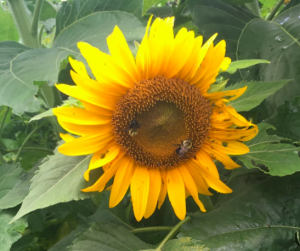Today’s post is a little different than the others, because I am exploring something I have wondered about since this summer. After my graduation, a friend of mine gave me a corner of her garden. In part this was to get me out of the house over summer break, but it also mean I could plant a pollinator garden! I was most excited for the sunflowers.

A Sunflower Opening It’s Anthers While Bees Pollinate (from my own garden)
At the end of August, I counted eight bees of at least three species, including bumblebees, honey bees and carpenter bees, on one flower head. Later, I observed the flower changing while the bees crawled on them; it appeared as though they were opening the inside petals or flowers or something inside the disc of the flower. I found this intriguing, especially upon realising I had no idea how sunflowers worked; I knew the inside disc would eventually become sunflower seeds, but how they came to that point confused me.
As it turns out, a sunflower’s most recognisable petals are nothing but sterile ray flowers, growing around the disc to attract pollinators. They unfold around the flower during blooming season and then fall off while the seeds mature. The real action is in the sunflower’s dark inner disc, which consists of hundreds of tiny flowers clustered together, with both male and female parts. These flowers will produce seeds after pollination. Similarly to the ray florets, the inner flowers begin flowering at one side of the head and open in rows at about 4 rows a day, depending on flower stress, temperature, water supply, sunlight and more. They open early in the morning, releasing anthers to form a tube; later in the same day pollen and the flower’s stigma extend, while the tube itself retreats. The exposed stigma must attract a pollinator or self pollinate within 2 days, or else it withers and the seed will remains useless. So while I was correct in noticing the gradual opening of the disc flowers, it was the flower itself opening and releasing its stigmas––not the bees.

A Sunflower with More Open Anthers
So then, what do bees do for sunflowers?
Many sunflowers can self pollinate, as pollen is spread by wind between florets in a single disc. However, insect pollination is more beneficial, especially in times of stress. Bees could increase self pollination rate, spreading it while crawling between florets on a single disc. Secondly, bees could also transfer pollen between rows, promoting greater genetic diversity. Bees also expedite the pollination process, pollinating the florets quickly enough the stigmas don’t wither away before pollination. It’s possible bumblebees are even better than honey bees at pollinating sunflowers, as they perform better in cooler temperatures, rainier climates, and with less sunlight.
I didn’t expect there to be as much research on this topic as there is when I first set out to learn about it! The bees naturally benefit from the abundance of pollen and nectar the massive flower heads produce, which is why you can see multiple bees on a single flower. And now we both know how sunflowers make those tasty seeds!
Connor, David J, and Anthony J. Hall. “Sunflower Physiology.” Sunflower Technology and Production, Agronomy Monograph 35. ASA, CSSA, SSSA, 1997. Ch 4, pg 113-182. doi:10.2134/agronmonogr35.c4

I love it when bees pollinate sunflowers. It’s so CUTE!!
It is nice to see a realistic article like this. Bees are extremely important, but not required for all crops.